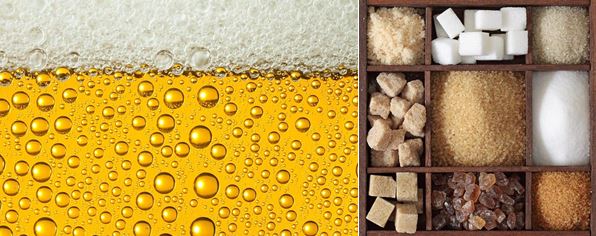
by Fern Shaw | Sep 15, 2015 | Health and Hydration, Water
Great excitement abounds as we draw closer to the 2015 Rugby World Cup being held in the U.K. this year, starting on 18 September and the final being played at Twickenham on 31 October. One would hope so, as rugby was invented in England in 1823. Legend has it that during a game of football at Rugby School in Warwickshire, a 16 year old student, William Webb Ellis, caught the ball and ran with it towards the opponent’s goal line, rather than following the rules of the times of catching and kicking the ball only.
From our side, as we’re all about things water, we’ve approached keeping hydrated from two angles – keeping yourself hydrated when playing the sport and how to keep yourself hydrated as a fan of the sport!
Perhaps you’re more couch potato than skinny fries when it comes to your sports participation. That’s why when you go from supine to five jumping jacks in a short time, you feel faint, you’re sweating bullets, your heart races, your face turns an interesting shade of puce and you may just feel like purging your most recent meal. This description should give you some idea of why your hydration needs are very different from your favourite rugby team.
Sports Hydration
As you can imagine, the physical and mental energy expended in a rugby match is monumental. In order to keep an athlete’s body (and mind) in peak condition, hydration and rehydration are of paramount importance. An example of just how important hydration is? A player can lose up to 3 to 4 kilograms during one match.
Although this year the temperatures won’t be soaring like they did at the 2013 Rugby League World Cup in Papua New Guinea, where the thermometer reached a cracking 33°C, players always go through strenuous pre-match tests to ensure that they are properly hydrated.
They are weighed before and after training, they have urine tests every day and they fill in wellness charts. If temperatures tend to soar during matches, additional breaks can be implemented during each half. The good news is that these players, their coaches and managers are all highly experienced. So, that’s them covered – now we worry about you, the supporter.
Supporter Hydration
Being a rugby supporter can also be very strenuous – take it from me – at the 2007 Rugby World Cup, there was a lot of supporting, jumping up and down, cheering and moaning going on, and we won’t make too much mention of the quaffing of the many shots in support of one’s national team – usually a concoction of luminescent coloured alcohol. Thirsty work all round, but quenching one’s thirst in the altogether incorrect manner with nary a bottle of water to be seen. Not the right way to stay strong for your team!
So in order to actually enjoy the entire event (instead of giving it your all during one match and spending the remainder of the World Cup hiding underneath your duvet), be kind to yourself:
If you’re fortunate enough to be attending the matches at any of the stadiums:
– Check to see if you can take your own water in with you.
– If you’re walking long distances to get to stadiums, as always, make sure you’ve plenty of bottled water to drink.
– If you’re staying home and know that your supporting is going to be a steady diet of drinking and fry-ups, try to make sure that before you get into supporter mode you drink lots of water. This will mean that you should have more energy in reserve when it comes to the all-important cheering, jumping up and down and singing mentioned beforehand.
Right, you’re sorted, my work here is done. If you need me, I’ll be the one in the Scotland rugby jersey, singing, ’Doe-a-deer’ and ‘Scoooootttlannnd / Scoooooooootttllannnnnd’.
On a more serious note, if you think you or your company will be thirsty during the World Cup, we are so the right people to speak to. Call us on 0800 772 3003 or e-mail us at shelly@aquaidwatercoolers.co.uk

by Fern Shaw | Sep 11, 2015 | Water
Everyone knows that if a person is in shock one of the most effective ways of combating it is to give the person some sugar water to drink. This raises the blood sugar levels almost immediately.
But perhaps we haven’t realised just how bad sugar can be for us and also how much of it can be found in our favourite tipple.
So before you think you’re in the clear when it comes to quaffing your drink of choice – here are a few indicators of just how much sugar is in your favourite bevy:
*Your quintessential GIN & TONIC contains four teaspoons of sugar.
VODKA & CRANBERRY contains a whopping 7.5 teaspoons of sugar. Admittedly vodka itself has pretty much zero sugar, but then we weren’t all brought up drinking neat vodka.
RUM & COKE contains a un(healthy) seven teaspoons of sugar.
When we move onto unmixed alcohol, like ciders, wines and beers, the results are a little more cheerful:
CIDER is probably the worst culprit, with around 5 teaspoons of sugar per bottle.
WHITE WINE has a lower sugar content – 1.5 teaspoons of sugar – but this of course depends on which white wine you’re drinking.
RED WINE is probably about your safest bet with only a quarter teaspoon of sugar per glass.
The good news is that BEERS and ALES contain the least sugar overall.
A bottle of BEER contains around 0.5 of a teaspoon of sugar and a bottle of ALE contains about 1 teaspoon.
So, although this should have you heading on down to your local and raising your glass, full of good beer cheer, you’ll need to bear in mind that a lot of your beers and ales also contain additives, corn syrups, preservatives and colorants.
Of course, seeing as AquAid are all about water, you have to have known that there had to be a mention in here somewhere, so here it is:
All of the above drinks start with water and a combination of processes, whether it’s mixing water with barley or water with potatoes – which is, I suppose, quite a plus – as this means, in essence, you are drinking water.
If it’s unlikely that you’re about to give up your favourite tipple, irrespective of how much or how little sugar it has – try this option out – for every drink you have, match it with a glass of water.
Then there’s the final option (which may just have the majority of us running for the hills with some home-made distilling type set-up) which involves ditching the drinks and all that sugar and sticking to drinking water. It may not give you the same kick as neat vodka will (also zero percent sugar) but you’ll never have to count sugar content again.
Bottoms up!
*Volumes here are loosely based on either a 500ml bottle or a glass of.

by Fern Shaw | Sep 11, 2015 | Water
I hope you aren’t surprised about the ‘I’ in the title; by now you should be well aware that a lot of this blogging stuff is about me. And why not – it is me that’s writing them after all.
I actually didn’t really trivia my way to fame – no Slumdog Millionaire me – however, I, like millions of humanoids, am fascinated by knowledge of the diverse. With this in mind, I present the 3rd in the series of Did You Know? trivia – facts and factoids to amaze your friends and colleagues with when you’re replenishing your water:
Queen Elizabeth II
The Queen Elizabeth II cruise liner has had one full-time resident for seven years. The passenger, an 87-year-old American widow has lived in a windowless modest cabin for seven years at a rent of £3,500 a month. (Fact for 9 Dec 2008).
“The whole nine yards”
It is believed that the term ‘the whole 9 yards’ came from WWII fighter pilots in the South Pacific. When arming their airplanes on the ground, the .50 calibre machine gun ammo belts measured exactly 27 feet, before being loaded into the fuselage.
Lexicon
The only 15-letter word that can be spelled without repeating a letter is uncopyrightable.
Executable offense
It is an executable offense to allow your pet to mate with a pet of the royal house without permission. I wonder how the Royal Corgis feel about that?
John Smith – lots of!
There are over 30,000 John Smiths in Britain.
Dodgy dicing
In the 1700s, men who ran illegal gambling houses hired a special person to swallow the dice if the police showed up.
Butler
The word ‘Butler’ was brought from France by the Normans around 1066 and is from the French word ‘bouteiller’ which means a man who bottles wine.
In the UK a private members organisation was founded in 1979 called, ‘The Institute of British Butlers’, aimed at providing advice and support for butlers in the UK.
by Fern Shaw | Jun 19, 2015 | Water
A while ago, I blogged about the dreaded headaches that affect most humanoids.
There are so many types of headaches, one hardly knows where to begin, but I’m going to give it the good old college try in the hopes that this will provide useful information so you can treat them appropriately the next time you experience one of these nasties:
Tension headaches – the most common type, feel like a constant ache or pressure around the head, especially at the temples or back of the head and neck. Not as severe as migraines, they don’t usually cause nausea or vomiting, and they rarely halt daily activities.
Over-the-counter treatments, such as aspirin, ibuprofen, or acetaminophen, are usually sufficient to treat them. One needs to always check the contra-indications, even with over-the-counter medications, as, for example, headache tablets containing aspirin can irritate one’s stomach lining. Experts believe these may be caused by the contraction of neck and scalp muscles (including a response to stress), and possibly changes in brain chemicals.
Cluster headaches, which affect more men than women, are recurring headaches that occur in groups or cycles. They appear suddenly and are characterized by severe, debilitating pain on one side of the head, and are often accompanied by a watery eye and nasal congestion or a runny nose on the same side of the face.
During an attack, people often feel restless and unable to get comfortable; they are unlikely to lie down, as someone with a migraine might. The cause of cluster headaches is unknown, but there may be a genetic component. There is no cure, but medication can cut the frequency and duration.
Sinus headaches – when a sinus becomes inflamed, often due to an infection, it can cause pain. It usually comes with a fever and can be diagnosed by symptoms or the presence of pus viewed through a fibre-optic scope.
Headaches due to sinus infection can be treated with antibiotics, as well as antihistamines or decongestants.
Rebound headaches – overuse of painkillers for headaches can, ironically, lead to rebound headaches.
Culprits include over-the-counter medications like aspirin, acetaminophen, or ibuprofen, as well as prescription drugs.
One theory is that too much medication can cause the brain to shift into an excited state, triggering more headaches. Another is that rebound headaches are a symptom of withdrawal as the level of medicine drops in the bloodstream.
Migraine headaches – migraines can run in families and are diagnosed using certain criteria:
- At least five previous episodes of headaches
- Lasting between 4–72 hours.
- At least two out of these four: one-sided pain, throbbing pain, moderate-to-severe pain, and pain that interferes with, is worsened by, or prohibits routine activity.
- At least one associated feature: nausea and/or vomiting, or, if those are not present, then sensitivity to light and sound.
A migraine may be foreshadowed by aura, such as visual distortions or hand numbness.
Last, but certainly not least, there are what I’ve coined as water headaches. A water headache isn’t, as one would think, a headache brought about by drinking ice cold water or eating ice cream, but headaches that occur precisely because we’re not drinking sufficient water.
Yep, can you Adam and Eve it – nasty, painful headaches can easily be brought on by not drinking enough water. Of course if you bash your head (or bash your head after falling down from imbibing too much alcohol, that’s a double trouble problem), and you’ve a sore head, drinking water isn’t going to help reduce that soreness, sorry for you.
But if you find that all of a sardine you’re experiencing more headaches than usual (and you haven’t bashed your head or pulled muscles and you’re not prone to migraines), there really is a simple and inexpensive solution to test the theory, dearie: up your water intake. You’ll be pleasantly surprised by the result.
by Fern Shaw | Jun 8, 2015 | Water, water cooler, Water Coolers
Last week I blogged about memes (see image above); the word itself always makes me a little uncomfortable – memes … Manitou’s …mammaries – but then that’s how my brain processes word association – it may not be how yours does. (Aren’t you lucky?!)
With memes in mind, I got to thinking about what it is that makes people associate water coolers (or more correctly – areas where water coolers are) with humour?
It’s pretty simple if you think about it – when people head off to replenish their daily H20 quota (and another Blogista aside – isn’t it nice to know that nowadays you have a plethora of water cooler machines to choose from – even ones to fit on your desktop – aha – like your desktop does) – it’s usually their downtime; take a break time; time to walk off work related stress; so ostensibly when they reach the water cooler and they see a colleague (or two or five), they remember that they haven’t shot the breeze; told the latest joke; compared footie scores; swapped a bit of skinny – so they break into full splab.
Of course this sharing can often have pretty dodgy and potentially disastrous results – perhaps *Tim in HR doesn’t appreciate Maggie from Sales telling off-colour jokes and Pandora from Filing is ready to throttle Syd from Social Media because he keeps on winding her up about his team’s great results versus hers.
I think that pretty much explains the humour at the water cooler connection. If you don’t believe me, then take a stroll down to your water cooler – I guarantee you’ll see my hypothesis in action. If there’s no humorous activity, create your own. Remember though – directing the water from the water spout to squirt at colleagues probably won’t be perceived as funny.
*names and characters in this blog are all fictional.
by Fern Shaw | Jun 8, 2015 | Water
I’m sure you all have a pretty good inkling about some elements of what your carbon footprint is and have, in your own way, implemented certain strategies on how to lessen that footprint.
But are you at all aware of what the water footprint is for each bit of food you consume?
Here are the water footprints for a few foods that may surprise you – making it high time perhaps to get the most out of your allotment or even your windowsill gardens for that matter.
1. Tomato: On average, one tomato (250 gram) costs 50 litres of water. Tomato sauce / ketchup costs 530 litres of water per kilogram of tomato ketchup.
Tomato puree costs 710 litres of water per kilogram of tomato puree.
2. A pound of lettuce = 114 litres
In general, vegetables take much less water to produce than animal products: That’s where the Meatless Monday suggestion comes in. You don’t need to go vegan, but every bit helps. Lettuces’ water footprint for the UK can be a lot higher as the produce can need to be brought in for consumption from other countries in the winter months.
3. A kilogram of chocolate = 17 000 litres
On average, cocoa beans have a water footprint of 20 000 litres/kg. Cocoa beans are first made into cocoa paste, with cocoa shells as rest product. About 97% of the total water footprint of cocoa beans is allocated to the cocoa paste that is derived from the beans; the rest is attributed to the by-products. One kilogram of cocoa beans gives about 800 gram of paste, so that the water footprint of cocoa paste is about 24 000 litres/kg. From this we can calculate that chocolate has a water footprint of about 17 000 litres/kg.
4. A slice of pizza = 159 litres of water
That would be 68 litres for the flour, 79 litres for the cheese, and nearly 11 for the sauce. Mozzarella, it turns out, is a real water sucker, as is any animal product. Of course, this is the global average, and water use per slice varies from country to country. French pizza has less than half this footprint, the US just about hits the average mark, and Chinese pizza is slightly more waterlogged.
Obviously, you can’t live on water alone (although it’s super important to ensure that you drink sufficient water), but perhaps spare a thought in future about where your food comes from.
*excerpts from Waterfootprint.org



